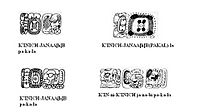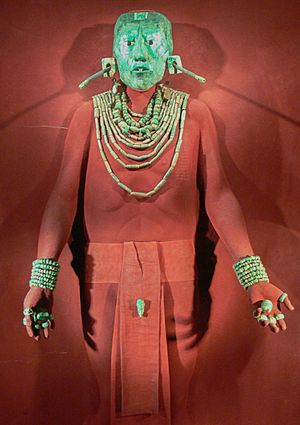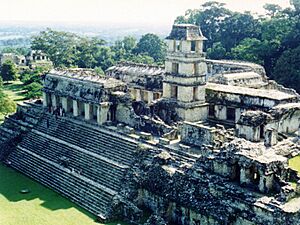Kʼinich Janaabʼ Pakal facts for kids
Quick facts for kids Kʼinich Janaab Pakal I |
|
|---|---|
| Kʼuhul Baakel Ajaw (Divine Lord of Palenque) |
|

Kʼinich Janaab Pakal's portrait in a lintel of 615
|
|
| King of Palenque | |
| Reign | 27 July 615 – 29 August 683 |
| Coronation | 27 July 615 |
| Predecessor | Sak Kʼukʼ |
| Successor | Kʼinich Kan Bahlam II |
| Born | 24 March 603 Palenque (now in Chiapas, Mexico) |
| Died | 29 August 683 (aged 80) Palenque |
| Burial | Temple of the Inscriptions, Palenque |
| Spouse | Ix Tzʼakbu Ajaw of Tortuguero |
| Issue | Kʼinich Kan Bahlam II Kʼinich Kʼan Joy Chitam II Tiwol Chan Mat (probable) |
| Father | Kʼan Moʼ Hiix |
| Mother | Sak Kʼukʼ |
| Religion | Maya religion |
| Signature |  |
Kʼinich Janaab Pakal I, often called Pakal the Great, was a very important ruler of the ancient Maya city of Palenque. He was born on March 24, 603, and ruled for a very long time, from July 615 until his death on August 29, 683.
Pakal was a powerful ajaw (a Maya ruler or lord) during the Late Classic period. He ruled for 68 years, which is one of the longest reigns in history. During his time, he helped Palenque become a strong and beautiful city. He built many famous buildings and left behind important carvings. Pakal is also well-known for the carved lid of his tomb, which some people have had unusual ideas about.
Contents
Understanding Pakal's Name
Pakal's full name was Kʼinich Janaab Pakal. This name means "Radiant Corn-Flower (?) Shield" in the Classic Maya language. Before experts could fully understand Maya writing, people called him by other names like "Sun Shield."
Sometimes, you might see him called "Pakal I" or "Pakal II." This can be a bit confusing! He is called "Pakal I" to tell him apart from later rulers of Palenque who had similar names. These include Kʼinich Janaab Pakal II and Janaab Pakal III. If he is called "Pakal II," it is usually to distinguish him from his grandfather, who was also named Janahb Pakal. However, his grandfather was not a king.
Pakal's Early Life and Rise to Power
Kʼinich Janaab Pakal was born in Palenque in March 603. His mother was Lady Sak Kʼukʼ, who came from the ruling family of Palenque. His father was Kʼan Moʼ Hiix.
Pakal's childhood was a difficult time for Palenque. A powerful rival city, Calakmul, had attacked Palenque just four years before he was born. Calakmul attacked again in 611 when Pakal was a young child. The king of Palenque and his heir (Pakal's grandfather) both died the next year. This caused a big problem for who would rule next.
Because of this, Pakal became the ruler of Palenque in July 615. He was only twelve years old. His mother, Lady Sak Kʼukʼ, ruled for him as a regent until he was old enough to take full control.
Pakal's Long Reign
Pakal greatly increased Palenque's power in the western Maya lands. He also started a huge building project in his capital city. This led to some of the most beautiful art and buildings in Maya history.
In March 626, Pakal married Ix Tzʼakbu Ajaw. She came from another important family. They had at least two sons, Kan Bahlam (born 635) and Kʼan Joy Chitam (born 644). They probably had a third son named Tiwol Chan Mat (born 648).
Over the years, Pakal's mother slowly gave him more power. She passed away in September 640. Pakal continued to expand Palenque's influence. In 628, one of his officials was captured by Piedras Negras, another Maya city. Soon after, Palenque captured the ruler of Santa Elena, making it a city that paid tribute to Palenque. In 659 and 663, Pakal also captured people from other cities like Pipaʼ and Santa Elena.
In 647, when he was 44, Pakal began his first building project, a temple called El Olvidado (The Forgotten). But his most impressive work was expanding the Palace of Palenque. He added many new rooms and even built a special white building called Sak Nuk Naah. The east court of the palace was used to celebrate military victories. Buildings B and C were finished in 661, and Building A in 668. Building A has paintings of prisoners captured in 662. Many important carvings and texts are linked to Pakal, including those found in the Palace and his tomb.
Pakal's wife, Tzʼakbu Ajaw, died in November 672 after they had been married for 47 years. Eight years later, his third son, Tiwol Chan Mat, also died. Pakal oversaw his burial.
Pakal's Death and Burial
Pakal died in August 683, when he was 80 years old. He had ruled Palenque for 68 years and 33 days.
After he died, Pakal was seen as one of the special gods who protected Palenque. His two sons, Kan Bahlam and Kʼan Joy Chitam, both became rulers after him.

Pakal was buried in a huge stone coffin inside the largest pyramid in Palenque. This pyramid is called the Temple of the Inscriptions. For a long time, no one knew how to get into his tomb. In 1948, a Mexican archaeologist named Alberto Ruz Lhuillier discovered a secret stone slab that led to it. It took four years to clear the path to the tomb, but it was finally opened in 1952.
Inside, Pakal's skeleton was still in his coffin. He wore a beautiful jade mask and necklaces made of beads. Around him were sculptures and carvings showing his journey to become a god and figures from Maya stories. These carvings were once brightly painted.
At first, some people wondered if the bones really belonged to Pakal. His teeth looked like they belonged to someone much younger than 80. However, experts who study Maya writing insisted that the texts clearly stated Pakal died at 80. More recent studies of his bones show that he was indeed an old man when he died. The reason his teeth looked younger is probably because as a rich ruler, Pakal ate softer foods than most Maya people. This meant his teeth did not wear down as much.
Archaeologists continue to learn more about Pakal's burial site. In 2016, an underground water tunnel was found beneath the Temple of the Inscriptions. In 2018, a stucco mask showing an elderly Pakal was also discovered.
Pakal's Sarcophagus Lid
The large carved stone lid of Pakal's coffin is a very special piece of ancient Maya art. It shows a large "world tree" in the middle. Around the edges are symbols for the sun, moon, and stars, along with the faces of six important noblemen.
Pakal himself is shown wearing special items, like a turtle ornament, which link him to the Maya maize god. He is in a unique position that might show him being reborn. The carving also shows a two-headed serpent, which often means entering the world of the dead.
Unusual Ideas About the Sarcophagus
Pakal's tomb has been the subject of some unusual theories, especially about "ancient astronauts." In 1968, a writer named Erich von Däniken wrote a book called Chariots of the Gods?. He showed a drawing of the sarcophagus lid and said Pakal's pose looked like an astronaut in a spaceship. He thought the drawings underneath Pakal looked like rockets. He suggested this was proof that aliens had visited the ancient Maya.
However, almost all archaeologists and experts on the Maya strongly disagree with this idea. They explain that von Däniken's claims only look at the pictures without understanding the full history, art, and beliefs of the Maya people. They point out that the images fit perfectly with Maya art, symbols, and stories about their gods and the universe.
Another unusual idea came from José Argüelles, who linked Pakal to a prophecy about the year 2012. These ideas are not supported by scientific or historical evidence.
See also
 In Spanish: K'inich Janaab' Pakal para niños
In Spanish: K'inich Janaab' Pakal para niños







